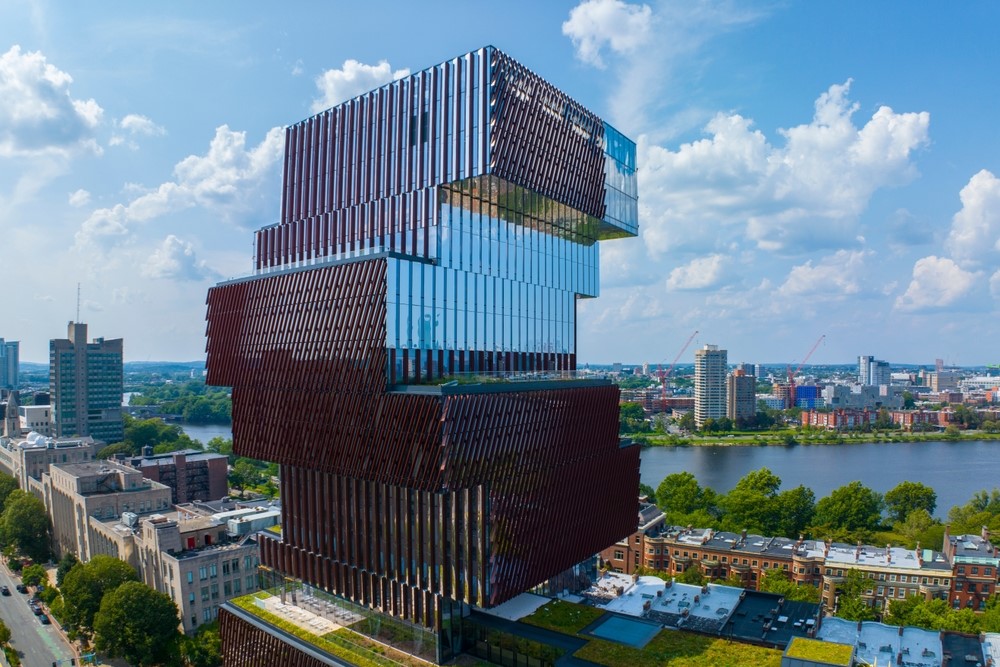Higher education plays a key role in how we address the challenges of climate change—not only in our scientific understanding of the cause and effect of carbon emissions, but also in how our built spaces can adapt. Because many college and university campuses feature historical (even outdated) infrastructure, many are taking opportunities to build new structures and renovate existing ones with sustainability in mind.

By leveraging new technologies, innovative design practices, renewable energy, and forward-thinking funding practices, college campuses set a high precedent for how today’s buildings can limit their environmental impact and thoughtfully contribute to the communities and world around them.
Boston University Weaves Smart Technology with Thoughtful Design to Create Green Buildings
As higher education evolves to reflect advancements in research, technology, and market demand, campuses in turn undergo change through new builds and retrofits. Boston University (BU) is a recent example of how sustainably minded universities are reflecting their values through their campus design. In December 2022, BU opened its Center for Computing & Data Sciences (CDS)—currently the university’s most sustainable building and the largest fossil-free building in all of Boston.
Energy efficiency is a key part of BU’s accomplishments with the new center. The use of electricity matched from renewable sources and geothermal energy significantly reduces the carbon emissions otherwise created by fossil fuels for heating, cooling, food services, and more. Smart technology identifies and acts on ways to further save energy—for example, the heavily windowed exterior has exterior shades that can be automatically adjusted to block sunlight, helping cool the building while also reducing glare on occupants’ screens inside.
Meaningful architectural choices also play a role in helping occupants make more sustainable choices within the building itself. CDS features a central staircase that looks over multiple stories as one goes up or down, offering students, employees and visitors a captivating view of the entire building and encouraging them to choose that experience instead of riding an elevator, therefore saving energy.
Thoughtful design choices like this, combined with innovative building technology, offer occupants unique and memorable experiences while reducing harmful emissions, making this new building compliant with Boston’s ordinance on emissions reductions.
The University of California Saves Costs Through Energy Efficiency Projects
The public University of California (UC) system consists of 10 campuses across the state. As the flagship research university in a state leading the U.S. in many sustainability initiatives, UC has also pioneered new approaches toward clean, efficient energy usage. One of the most considerable projects it has taken on is the UC Clean Power program. By partnering with clean energy providers across the state, UC is selling renewable energy directly to its campuses to replace bought electricity from other energy providers. As of 2022, UC Clean Power supplies about 40% of all purchased power across the UC system, and 55% of the entire system’s electricity is sourced from clean and renewable energy.
The program, in conjunction with over 100 other energy projects and 408 LEED-certified buildings across every campus, makes UC the biggest green energy user among all U.S. colleges and universities, according to the EPA. The UC system has avoided over $300 million in utility costs thanks to these initiatives and is on track to reach its goal of 100% clean energy by 2025.
With over 35 million square feet of green buildings across the state—a number that will only grow as the campuses expand—UC sets a positive example for how other multi-campus education systems can partner with others and build for a sustainable future.
Weber State University Reinvests Its Energy Savings into Future Green Projects
East of Utah’s Great Salt Lake, Weber State University is working toward achieving a carbon-neutral campus by 2040—recently moved up from its initial 2050 goal thanks to the university’s ongoing investments into sustainable operations. One of the major benefits of any energy efficiency project is cost savings for an entire organization, and Weber State is using these savings to keep propelling its initiatives forward.
Weber State has a revolving “green fund” into which the university invests $5 million at a time to fund different energy projects; for example, installing LED lighting, efficient windows, and water-cooled, ground-sourced variable refrigerant flow for HVAC systems to maximize energy efficiency throughout its buildings. These efforts result in financial savings, which in turn go back into the green fund (restoring it after using all initial funds first) for the next round of sustainability projects.
These efforts not only save money for Weber State, but make the campus more resilient to changing climate conditions and regulations around preserving energy and resources. Utah recently passed a state mandate requiring a 25% reduction in water use by 2026, which Weber is already prepared for thanks to its investments into its future operations.
Lessons in Sustainability
College campuses across the U.S. are helping drive sustainable facilities forward. From creating green budgets, to overseeing innovative building design and smart tech installation, higher education is helping lead the way to how both old and new structures can adapt to the current and future realities of climate change.
These ongoing investments into new construction, retrofits, and facilities management are helping to create more resilient communities and centers of education, as well as setting an achievable standard for how any organization can work toward carbon neutrality and sustainable operations.

The co-authors are from Acuity Brands, where Chelsea Davis is senior product manager of Atrius and Lauren Scott is vice president of marketing and sustainability of the Intelligent Spaces Group.
ALSO READ: University of Connecticut’s Director of Major Projects Talks Campus Sustainability
